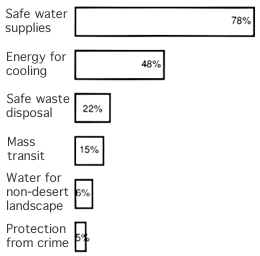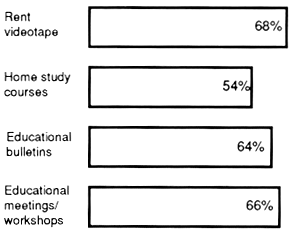Summer 1991 // Volume 29 // Number 2 // Feature Articles // 2FEA2
Reactions to Alternative Delivery Methods
Abstract
The results of this study can positively affect both Extension faculty and programming as we near the 21st century. Change will continue. Demands on people's time will grow, but working people can watch a professionally produced educational videotape while riding an exercise bicycle. Retirees can study in an Extension-produced home study course at their leisure. To survive and flourish in this highly competitive environment, Extension faculty will have to regroup. Training to produce professional, educational television programs and videotapes can no longer be looked on as a luxury to do "someday," but as an immediate necessity.
How people prefer to learn depends on what they're learning. Television, radio, and newspapers are the preferred sources of educational information on energy conservation.1 But change the subject to financial and health management, then pamphlets, correspondence courses, and recorded telephone messages become the methods of choice.2 Entering the 1990s, environmental topics are emerging as high-priority issues for Extension.3 A University of Arizona research project determined that people prefer to learn about environmental issues in yet another way.
Identifying Issues
In 1988, we surveyed University of Arizona employees, ages 40 to 65, working in positions ranging from grounds maintenance workers to upper administration.4 A mail questionnaire was sent to 850 employees with a 71% return rate. The survey focused on problems resulting from growth and development in Arizona. Questions included environmental and policy issues of most concern to the employees when they thought about continuing to live in Arizona.
Analysis of the data indicated that, in order of importance, priority issues were (see Figure 1):
- Availability of safe and plentiful water.
- Affordable energy.
- Safe waste disposal.
- Air pollution.
- Mass transportation systems.
- Protection from crime.

Figure 1. Respondents' concerns on environmental and public policy issues.
There were no significant differences in these results by age, education, occupation, and years to retirement.
Extension Education on These Issues
Recognition and ordering of these issues is just the beginning. What are effective methods of reaching people with information about these issues?
Cooperative Extension in Arizona has traditionally offered educational programs at daytime or evening meetings. Lifestyles and economic changes mean Extension has to reevaluate delivery methods and services. To determine how today's populations would be willing to receive information about community issues, respondents were given a list of alternative information delivery methods and asked to indicate their willingness to participate. These methods included renting videotapes for home use, enrolling in home study courses, purchasing bulletins and other printed materials, and/or attending educational meetings held within the community area. Figure 2 shows the results.

Figure 2. Acceptance of dissemination methods.
Rent Videotapes
Sixty-seven percent of the respondents said that they were willing to rent videotapes. However, as age increased their willingness to rent decreased. Within the age group 40-45, 82% said yes to rentals, while only 54% of those over 61 were willing to rent. As educational level increased so did the willingness to rent videotapes, with respondents having earned technical school and junior college degrees the most willing to rent the tapes.
The average rental price most respondents (54%) were willing to pay was $1.00-$2.99. If the price was increased to $3.00- $4.99, only 28% would pay and those respondents tended to be over 55. Those few who were willing to pay rental charges of $5.00- $6.99 had doctoral degrees.
Home Study Course
Overall, 54% were willing to enroll in a home study course, but older respondents were less willing to participate this way. Seventy-one percent of those aged 40-45 were willing to participate in such an activity, while that figure dropped to 44% among those over 60. Although the 40-45 age group was most willing to participate, they were the least willing to pay more than $14.99. The remaining participants were willing to pay in the range of $15.00-$20.00 for the home study course. The higher the educational level, the more willing the respondents were to pay the higher fee.
Educational Bulletins
Bulletins and other free educational materials have long been a staple of Extension. Budget cuts have forced many offices to charge for published information. Results of this study indicated that respondents' level of education didn't influence decisions about paying for bulletins. As age increased, willingness to pay for bulletins also increased, but not at increasing prices. The most acceptable price range was $2.00 or less; the least acceptable, $3.00-$4.99. This is encouraging considering current Extension resources.
Educational Meetings
Extension will continue to offer educational meetings in local communities. Ten miles was the maximum distance respondents were willing to drive to attend meetings. As respondents' age and educational level increased, the distance they were willing to drive decreased.
Implications for Extension
The availability of a safe and plentiful water supply was most important to the respondents in this study, lending support to Extension's efforts in issues-based programming at the local, state, and national levels. People were willing to accept alternative delivery methods like renting educational videotapes. The availability of electronic equipment like satellite dishes in remote, rural areas also increased willingness to participate in lifelong learning. Extension faculty need to hone their skills in teaching about critical environmental issues like water quality by both live and taped television programming.
People were reluctant to drive long distances to obtain educational information, but studying at home was a different matter. Since some respondents were willing to pay up to $20 to enroll in a home study course, Extension should make greater use of this delivery method.
The results of this study can positively affect both Extension faculty and programming as we near the 21st century. Change will continue. Demands on people's time will grow, but working people can watch a professionally produced educational videotape while riding an exercise bicycle. Retirees can study in an Extension-produced home study course at their leisure. To survive and flourish in this highly competitive environment, Extension faculty will have to regroup. Training to produce professional, educational television programs and videotapes can no longer be looked on as a luxury to do "someday," but as an immediate necessity.
Footnotes
1. D. R. Iams and M. S. Wilhelm, "The Public's View of Energy Education," Journal of Extension, XXII (November/December 1984), 11-14.
2. V. E. Steinfelt and D. R. Iams, "So You're Planning a Money Management Program!" Journal of Extension, XXIII (Winter 1985), 15-17 and B. A. Epstein, "Instant Health Information," Journal of Extension, XXVI (Spring 1988), 14-17.
3. Steinfelt and Iams, "So You're Planning a Money Management Program!"
4. Western Region Project, Housing and Locational Decisions of the Maturing Population: Opportunities for the Western Region (Tucson: University of Arizona, College of Agriculture, Agricultural Experiment Station, 1989).
